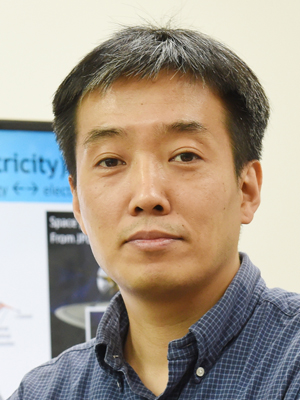연구/산학
PKNU Research 1000
| Hwang Jae-Yeol | Develops a high-performance 2D thermoelectric thin-film that 'sticks to plastics and glass' | |||
| 작성자 | 대외협력과 | 작성일 | 2021-08-04 |
| 조회수 | 1220 | ||
| Hwang Jae-Yeol | Develops a high-performance 2D thermoelectric thin-film that 'sticks to plastics and glass' | |||||
 |
대외협력과 |  |
2021-08-04 |  |
1220 |
PKNU develops a high-performance 2D thermoelectric thin-film that 'sticks to plastics and glass'
Professor Hwang Jae-Yeol

A technology that can transfer a high-performance two-dimensional thermoelectric Membrane to semiconductor substrates (wafer), as well as plastic or glass, which is attracting attention as a next-generation energy conversion device, has been developed. Professor Hwang Jae-Yeol (Dept. of Physics) at Pukyong National University, together with Professor Kim Sung-Wng (Department of Energy Science) at SungKyunKwan University, developed a technology that can separate and apply a high-performance two-dimensional thermoelectric thin film from a substrate, and recently published their findings in the world-renowned scientific journal (ACS Energy Letters, IF 23.101)>. A Thermoelectric Membrane is a thin film made of thermoelectric material that converts heat into electrical energy. It is a next-generation device that can be applied to wearable devices, the Internet of Things, and smart sensors. Research related to this has been increasing since the recent discovery of excellent properties in 2D thin films. Professor Hwang's research team has developed a technology that can achieve exceptional thermoelectric energy conversion efficiency by growing (forming) a thin film through an epitaxial process (vdWE: spontaneous van der Waals epitaxy), then separating the epitaxial thin-film from the growth substrate without damage and transferring it onto a curved surface or a flat surface.
The research team succeeded in transforming a pseudo-morphic Te (tellurium) monolayer on the surface of a sapphire substrate and grown as a BST membrane. At the same time, they made the substrate and the film weakly bond through an epitaxy process using the van der Waals force, an interaction between atoms, and selectively removed this bond using a solvent to maintain the crystal structure while minimizing the loss of physical properties. Professor Hwang said, "Through this research, high-performance two-dimensional thermoelectric thin-films, which could only be grown on limited substrates, can be transferred and utilized not only on the substrates but also on various types of materials such as plastics and glass. In this regard, this study suggested the development of a new concept device and the possibility of the new application of the 2D thin-film." "As this research is based on the surface properties of sapphire substrates widely used in semiconductor and electronic fields, I am expecting that various applications of this technology can be applied in the future, and high-performance thin-film energy devices that can be used in wearable devices can be developed," he added.
연구진
황재열 jaeyeol@gmail.com
자연과학대학 스마트소재물성연구실